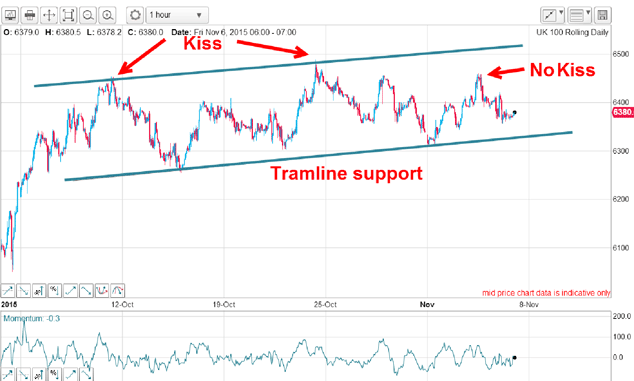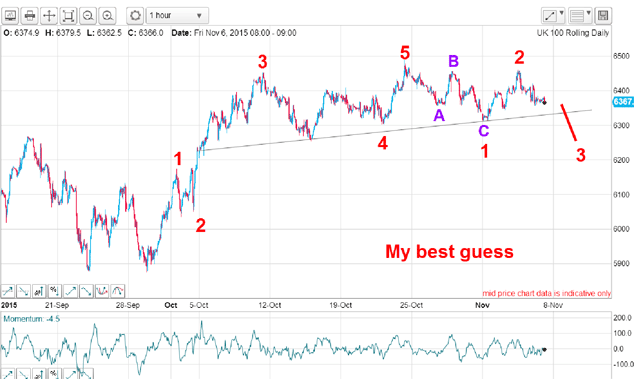I got stopped out of the FTSE but I knew there was profit
You can be wrong the first time and right the second, says John C Burford. The key is to trust in your trading methods.
Like most children, my parents told me "when at first you don't succeed, then try, try again." But like all pithy advice, that maxim is only useful some of the time. The rest of the time, it can get you in trouble.
In my post of last Friday, I outlined a failed trade in the FTSE. I managed to find a head fake on the hourly chart and took a 25-pip loss. I was looking for a short trade and came a cropper (though my 3% rule minimised my losses).
Would it be madness to try, try again?
Subscribe to MoneyWeek
Subscribe to MoneyWeek today and get your first six magazine issues absolutely FREE

Sign up to Money Morning
Don't miss the latest investment and personal finances news, market analysis, plus money-saving tips with our free twice-daily newsletter
Don't miss the latest investment and personal finances news, market analysis, plus money-saving tips with our free twice-daily newsletter
The first rule of trading: know yourself
If you know you are a rather timid trader, then you must overcome your natural caution when you see another opportunity. Likewise, if you are more gung-ho, then you would be advised to reassess the evidence calmly before acting. Trading, as in all of life, is a balancing act. Good traders are always self-correcting.
I am a reasonably adventurous trader and I had determined my original analysis was still valid. I therefore made another attempt at finding a trade on the short side.
I had my new blue tramlines in place and believed they were excellent lines of resistance (upper) and support (lower). If the market moved above my upper tramline, then I could infer the rally was not over. But the latest attempt to push higher was thwarted some distance shy of the upper tramline and failed to kiss it. That provided a clue that the market would likely now test the lower tramline support.
This was the chart last Friday:

If the market were to break that line, the decline should be substantial. That is because many of the longs who had gathered in the trading zone between my tramlines would have placed protective sell stops under the tramline.
I didn't have to wait very long. On Monday, the market broke hard through my lower tramline and I was in with a short position (with protective stop just above the line).

Note that following the break, the market rallied to place a traditional kiss on the underside of the tramline and then peeled away. I like to see tramline kisses, because it helps verify that I have highly reliable lines of support (which were drawn in well before the kiss). My lower tramline is now a line of resistance.
My Fibonacci levels have confirmed my target
I also drew in the Fibonacci levels of the latest large wave:

Yesterday, the market bounced off the Fibonacci 38% support in a textbook demonstration of how effective these Fibonacci levels are in forecasting support and resistance levels.
But my main target is still T3 where it crosses the Fibonacci 50% level.
I have now moved my protective stop to break even, following my rule. So whatever happens, I have a no-risk trade unless the market catches a huge bid which could leap over my stop level. This is a clear danger for individual shares that do not trade 24/7, where an overnight news item can result in a huge gap opening. But it is far less likely in one of the world's major stock indices that does trade 24/7.
That is why I prefer to trade these large markets where liquidity is greatest.
John is is a British-born lapsed PhD physicist, who previously worked for Nasa on the Mars exploration team. He is a former commodity trading advisor with the US Commodities Futures Trading Commission, and worked in a boutique futures house in California in the 1980s.
He was a partner in one of the first futures newsletter advisory services, based in Washington DC, specialising in pork bellies and currencies. John is primarily a chart-reading trader, having cut his trading teeth in the days before PCs.
As well as his work in the financial world, he has launched, run and sold several 'real' businesses producing 'real' products.
-
 The industry at the heart of global technology
The industry at the heart of global technologyThe semiconductor industry powers key trends such as artificial intelligence, says Rupert Hargreaves
By Rupert Hargreaves Published
-
 What are shareholder voting rights and why do they matter?
What are shareholder voting rights and why do they matter?If you hold shares in a company, the chances are they’ll come with voting rights. But how do you exercise your right to vote? And is your fund manager taking it seriously?
By Katie Williams Published